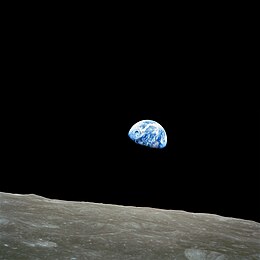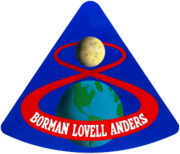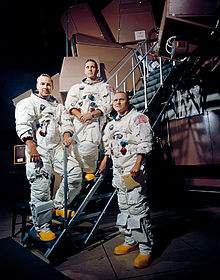അപ്പോളോ 8
ദൃശ്യരൂപം
 The crew of Apollo 8 were the first humans to witness Earthrise, on December 24, 1968 | |||||
| ദൗത്യത്തിന്റെ തരം | Manned Lunar orbiter | ||||
|---|---|---|---|---|---|
| ഓപ്പറേറ്റർ | NASA[1] | ||||
| COSPAR ID | 1968-118A | ||||
| SATCAT № | 3626 | ||||
| ദൗത്യദൈർഘ്യം | 6 days, 3 hours, 42 seconds | ||||
| സ്പേസ്ക്രാഫ്റ്റിന്റെ സവിശേഷതകൾ | |||||
| സ്പേസ്ക്രാഫ്റ്റ് | Apollo CSM-103 Apollo LTA-B | ||||
| നിർമ്മാതാവ് | North American Rockwell | ||||
| വിക്ഷേപണസമയത്തെ പിണ്ഡം | CSM: 28,870 കിലോഗ്രാം (63,650 lb)[2] CM:5,621 കിലോഗ്രാം (12,392 lb) SM:23,250 കിലോഗ്രാം (51,258 lb) LTA: 9,000 കിലോഗ്രാം (19,900 lb)[3] | ||||
| ലാൻഡിങ് സമയത്തെ പിണ്ഡം | 4,979 കിലോഗ്രാം (10,977 lb) | ||||
| സഞ്ചാരികൾ | |||||
| സഞ്ചാരികളുടെ എണ്ണം | 3 | ||||
| അംഗങ്ങൾ | Frank F. Borman, II James A. Lovell, Jr. William A. Anders | ||||
| Callsign | Apollo 8 | ||||
| ദൗത്യത്തിന്റെ തുടക്കം | |||||
| വിക്ഷേപണത്തിയതി | December 21, 1968, 12:51:00 UTC | ||||
| റോക്കറ്റ് | Saturn V SA-503 | ||||
| വിക്ഷേപണത്തറ | Kennedy LC-39A | ||||
| ദൗത്യാവസാനം | |||||
| തിരിച്ചിറങ്ങിയ തിയതി | December 27, 1968, 15:51:42 UTC[4] | ||||
| തിരിച്ചിറങ്ങിയ സ്ഥലം | 8°8′N 165°1′W / 8.133°N 165.017°W[4] | ||||
| പരിക്രമണ സവിശേഷതകൾ | |||||
| Reference system | Selenocentric | ||||
| Periselene | 110.6 കിലോമീറ്റർ (59.7 nmi) | ||||
| Aposelene | 112.4 കിലോമീറ്റർ (60.7 nmi) | ||||
| Inclination | 12 degrees | ||||
| Period | 2 hours | ||||
| Epoch | December 24, 1968, ~02:30 UTC | ||||
| Lunar orbiter | |||||
| Spacecraft component | CSM | ||||
| Orbital insertion | December 23, 1968, 21:59:52 UTC | ||||
| Orbital departure | December 24, 1968, 18:10:16 UTC | ||||
| Orbits | 10 | ||||

| |||||
അപ്പോളോ-8 1968 ഡിസംബർ 1നു കുതിച്ചുയർന്നു .ഫ്രങ്ക് ബോർമാൻ, വില്യം ആൻഡേഴ്സ് എന്നിവരായിരുന്നു അതിലുണ്ടായിരുന്നത്.അത് ചന്ദ്രന്റെ ഭ്രമണപഥത്തിലെത്തുകയും 109 കി.മി ഉയരത്തിൽ 10 പ്രാവശ്യം ചന്ദ്രനെ ചുറ്റുകയും ചെയ്തു മനുഷ്യനെ വഹിച്ചു കൊണ്ട് ഒരു വാഹനം ആദ്യമായി ഭൂമിയുടെ ഭ്രമണപഥത്തിനപ്പുറത്ത് എത്തുന്നത് അപ്പോളോ-8ലൂടെയാണു[5].
അവലംബം
[തിരുത്തുക]- ↑ Orloff, Richard W. (സെപ്റ്റംബർ 2004) [First published 2000]. "Table of Contents". Apollo by the Numbers: A Statistical Reference. NASA History Series. Washington, D.C.: NASA. ISBN 0-16-050631-X. LCCN 00061677. NASA SP-2000-4029. Archived from the original on ഓഗസ്റ്റ് 23, 2007. Retrieved ജൂൺ 28, 2013.
{{cite book}}:|work=ignored (help); External link in|chapterurl=|chapterurl=ignored (|chapter-url=suggested) (help) - ↑ "Apollo 8 Press Kit" (PDF) (Press kit). NASA. ഡിസംബർ 15, 1968. pp. 33–34. Release No. 68-208. Retrieved ജൂൺ 28, 2013. – The spacecraft mass at launch includes the CM and SM, but excludes the 4,000 കിലോഗ്രാം (8,900 lb) Launch Escape System (LES), which was discarded before reaching Earth orbit.
- ↑ "Apollo 8 Mission Report" (PDF). NASA. ഫെബ്രുവരി 1969. p. A-14. MSC-PA-R-69-1. Archived from the original (PDF) on മാർച്ച് 2, 2013. Retrieved ജൂൺ 28, 2013. – The mass for LTA-B was less than that of a flying LM, because it was essentially a boilerplate decent stage. A fully loaded, flight-ready LM, like the Eagle from Apollo 11, had a mass of 15,095 കിലോഗ്രാം (33,278 lb), including propellants.
- ↑ 4.0 4.1 "Apollo 8 Mission Report" (PDF). NASA. ഫെബ്രുവരി 1969. p. 3-2. MSC-PA-R-69-1. Archived from the original (PDF) on ഡിസംബർ 22, 2016. Retrieved ജൂൺ 28, 2013.
- ↑ Galileo Little Scientist,sarva siksha abhayaan page 20

